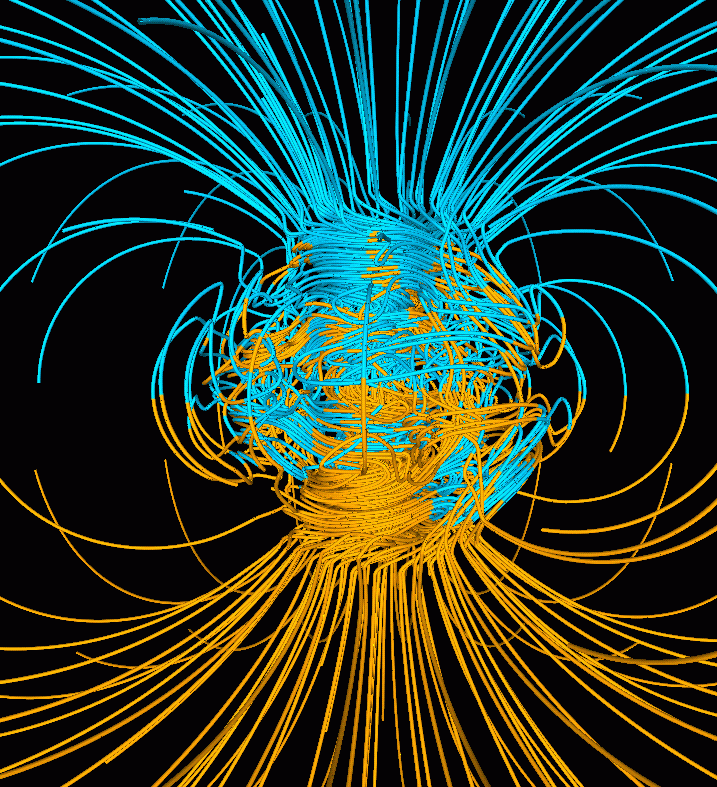Earth’s magnetic field is not normal at south atlantic
This article originally was published on The Conversation.
The earth is covered with magnetic fields. It is what the compass points to the north and protects our atmosphere from constant bombardment from space by charged particles like protons. Without a magnetic field, our atmosphere could be gently dismantled with harmful radiation, and as today, life was almost non-existent.
You might think that the magnetic field has a timeless, fixed direction of life on earth and to some extent you may be right. But the world’s magnetic field is actually changing. Every so often — on the order of several hundred thousand years or so — the magnetic field has flipped. North has pointed south, and vice versa. And it also tends to be very weak when the field changes.
What currently has geophysicists like us abuzz is the realization that the strength of Earth’s magnetic field has been decreasing for the last 160 years at an alarming rate. This collapse is focused on the great expansion of the Southern Hemisphere, known as the South Atlantic Anomaly, and extending from Zimbabwe to Chile. The magnetic field strength is so weak there that it’s a hazard for satellites that orbit above the region — the field no longer protects them from radiation which interferes with satellite electronics.
And the field is continuing to grow weaker, potentially portending even more dramatic events, including a global reversal of the magnetic poles. Such a major change will affect our navigation systems and the transmission of electricity. The spectacle of the northern lights might appear at different latitudes. And because more radiation would reach Earth’s surface under very low field strengths during a global reversal, it also might affect rates of cancer. By adding urgency to our research, we cannot fully understand the extent of these effects. To address this, we are looking for some unexpected data sources, including 700 years of African archaeological records.
 Credit: KELVINSONG, CC BY-SA
Credit: KELVINSONG, CC BY-SA
The magnetic field of the earth has been created by the introduction of iron in the liquid outer core of our planet. From the wealth of observatory and satellite data that document the magnetic field of recent times, we can model what the field would look like if we had a compass immediately above the Earth’s swirling liquid iron core. These analyses reveal an astounding feature:
- The reverse polarity under South Africa, along the core-mantle border where the liquid iron outer core joins with a slightly harder part of the Earth’s inner part. In this area, the polarity of the field is opposite to the average global magnetic field. If we could use a compass in the depths of South Africa, we can see that the north is actually showing the south on this unusual slope in the north.
 Credit: MICHAEL OSADICW/JOHN TARDUNO, CC BY-ND
Credit: MICHAEL OSADICW/JOHN TARDUNO, CC BY-ND
The poles have reversed frequently over the history of the planet, but the last reversal is in the distant past, some 780,000 years ago. The rapid decay of the recent magnetic field, and its pattern of decay, naturally raises the question of what was happening prior to the last 160 years.
Magnetic field flow
Sampling in the Limpopo River Valley locations, A.D. Between the years of 1000 and 1600 it revealed the first archaeomagnetic history for South Africa. What we found is that around 1300 A.D. Then the density increased at a much slower rate.
Two years of rapid field deterioration - 700 years ago and one day - suggests a recurring phenomenon. Could the current reversal of reversed flux correction records under South Africa have been more than regular in time? If so, then why does this occur again?
Over the last decade, researchers have accumulated images from the analyses of earthquakes’ seismic waves. As seismic shear waves move through the Earth’s layers, the speed with which they travel is an indication of the density of the layer. Now we know that a large area of slow seismic shear waves characterizes the core mantle boundary beneath southern Africa.

This particular region underneath southern Africa has the somewhat wordy title of the African Large Low Shear Velocity Province. Although it is descriptive, but many jargon-rich whips, it is a profound property that should be tens of millions of years old. While thousands of kilometers across, its boundaries are sharp. Interestingly, the inverted flux patch almost coincides with the eastern edge.
We think that these inverted patches will grow rapidly and will open more slowly. Sometimes a patch can grow to dominate the magnetic field of the Southern Hemisphere - and the poles are reversed.
The idea of conventional reversal is that they can start anywhere in the core. Our conceptual model suggests that there may be special places at the core-mantle boundary that promotes reverse-environment. We do not yet know if the current field is going to reverse in the next few thousand years, or simply continue to weaken over the next couple of centuries.


Comments